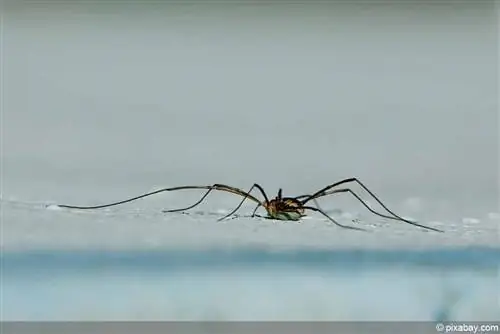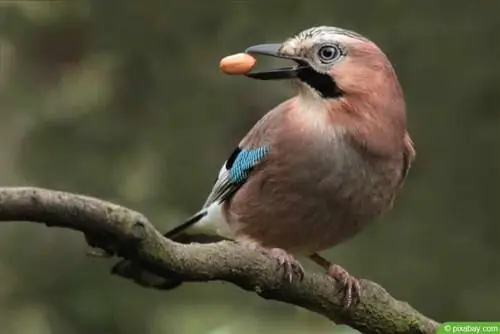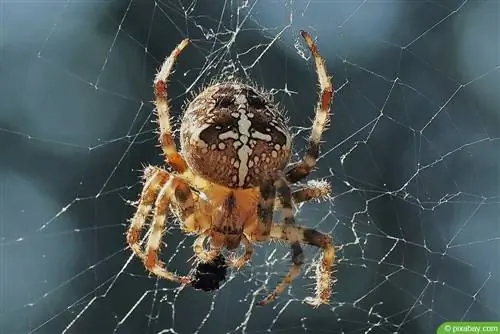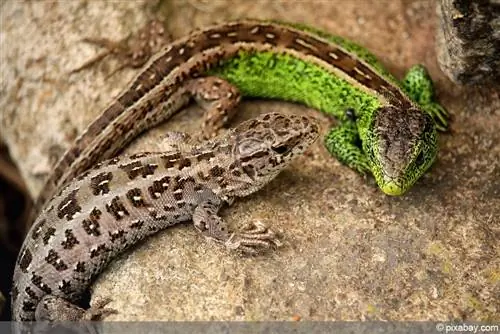- Author admin [email protected].
- Public 2023-12-17 03:39.
- Last modified 2025-01-24 12:45.
There is hardly a place on planet Earth where arachnids don't crawl around. Some species are also native to this country, such as the harvestman spider. It quickly scurries around on its long legs and even appears in our rooms. Every now and then she hears screams of horror. Admittedly, she is not suitable as a pet, but is she also dangerous?
One arachnid, many names
If the harvestman spider doesn't mean anything to you, then it could just be because of the unknown name. This creature has several of them, depending on the area in which it is mentioned. You may know this crawling animal as a shoemaker or tailor. In some places it also has somewhat strange names such as Grandpa Langbein or Kanker. The Swiss simply call this arachnid carpenter, the scientific name for harvestmen is opiliones. Many of these names may be unfamiliar, but this arachnid certainly isn't. Everyone gets to see harvestmen every now and then, especially because they like to spend time in our rooms.
This arachnid is not a spider
The harvestmen are arachnids, just like the “real” spiders. But harvestmen are not spiders, even if their appearance strongly suggests that. They look very similar to spiders. Only those who look more closely can notice the subtle differences. How to recognize harvestmen:
- have eight legs, like all arachnids
- Legs are usually very long
- each running leg has many joints
- two tactile organs are in the mouth area
- Tactile organs look like shorter legs
- only have two eyes (spiders usually have eight)
- uniform, oval body (spider body consists of two parts)
- Body color can vary depending on the species, but is usually gray or brown
- some species have a clearly patterned back part
- are out at dusk or at night
- have no web glands
- thus they do not spin webs
Note:
A little more than 100 species of harvestman spider live in Central Europe. They can differ in appearance in some features.
Identifying the cobbler in the aisle
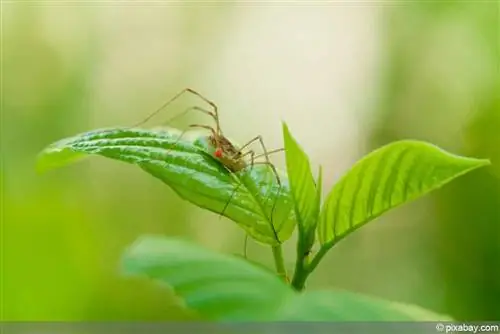
Thin, long legs are typical of cobblers. They have a lot of joints and are therefore extremely mobile. They give the harvestmen a gait that makes them easy to recognize. You use your legs to scan your surroundings as you walk. They are good climbers and are often spotted outdoors on bushes. They can wrap each leg around blades of grass, twigs or leaves as they wish, as if it were a lasso. Secured in this way, they move skillfully from one plant to another, even if the walk seems a bit wobbly.
Note:
The legs of some harvestmen species can be 20 times longer than their body. It is not yet clear scientifically why they need long legs.
Are harvestman spiders poisonous?
Harvest spiders do not have poison glands like poisonous spiders. However, they can produce similar secretions in their stink glands. The smelly secretion serves their own protection. This allows them to deter attackers and thus successfully ward them off. The species that live in this country pose no danger to humans because they cannot bite poisonously. Not only do they not pose a life-threatening threat, they also cannot cause us any other pain.
The tailors' favorite dishes
Harvest harvestmen feed on tiny parts of plants. They use their jawed claws to search the immediate surroundings for them. Dead small animals are also on their menu. They also catch small arthropods, which they eat alive. However, the captured arthropods are microscopic. Since they do not disdain either plant or animal food, harvestmen can be described as omnivores. But they also have natural predators in the wild: birds, frogs, bats, fire salamanders and spiders. They are safe from most of these enemies indoors. Except for spiders, these are extremely rare to find in a house.
Note:
Did you know that when harvestmen are attacked, they simply drop a leg? They leave it to the enemy and can escape. However, the lost leg no longer grows back.
The ancestral habitats
Most harvestmen live outside in the wild. They can be found in meadows, trees and bushes. They can also be found as ground dwellers. Some of them live on house walls or invade people's living spaces. If they are left alone, they take full advantage of the environment as a habitat. They can be found in large numbers, especially in abandoned houses, rarely entered cellars or overgrown gardens. But even in a well-kept garden they can never be completely kept away. From there you can easily find your way into the inhabited house.
Weberknecht as roommate
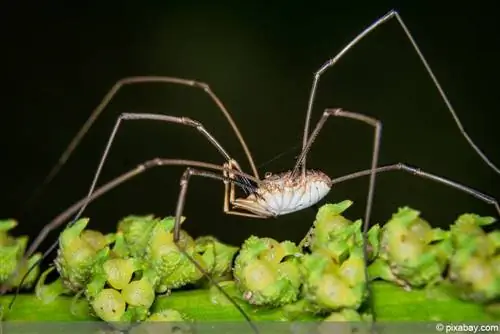
When a harvestman spider enters a house and lives in it, it is rarely welcome. Not only people with arachnophobia have an aversion to this cohabitant, no one else wants to tolerate them in their own four walls either. It's not dangerous and doesn't spin annoying webs, but who knows where it moves unnoticed. It may crawl over your face or even into your mouth at night while you are unsuspectingly dreaming. As soon as such an animal is spotted, everything is done to get rid of it quickly before it can crawl away. The “hitting” method is often used because it promises certain success. But that doesn't have to be the case, because the harvestmen are otherwise useful animals. Some species are even endangered.
How to get rid of the harvestman spider
Many people don't want to get too close to the harvestman spider. That's why they come in with the vacuum cleaner. The strong suction power is intended to destroy the delicate spider body without leaving any residue on the walls. But the delicate body only looks fragile, but in reality it is surprisingly resilient and usually survives this procedure. If the vacuum cleaner bag is not taken out of the house immediately and disposed of safely, the cobbler will be out again in no time. Instead of trying to kill the harvestman spider in other ways, it is better to remove it from the house alive. To do this, you simply grab her by one leg and carry her out. If you don't want to touch them, you can put a container over them and then slide a leaf underneath. Now she can be taken out and released.
Tip:
During the day, the nocturnal harvestmen hide in their shelters. So if you want to specifically search your home for them, you should do it after dusk.
How to keep the harvestman spider away
Whenever you spot a harvestman spider in your house, you can struggle to catch it and carry it out. A copy will probably appear again in the foreseeable future. If you don't want to fight these arachnids again and again, it is advisable to keep them out of the indoor areas completely. To do this, the harvestman spider's access to the house must be effectively blocked. A fly screen on windows and doors keeps the annoying long-legged creatures out. To prevent them from slipping through side cracks, gaps and cracks must be sealed with silicone. The lifespan of the fly screens is limited, so they must be replaced at regular intervals of a few years.
Distribute cobbler with lavender
Lavender is another completely natural remedy against these pests. Most people find the scent of lavender extremely pleasant, whereas cobblers are put off by it. Lavender sachets or lavender oil can be distributed in suitable places. Cobblers who are already in the house will quickly leave because of this unpleasant smell. Others will not even enter the house.
Chemical agents against harvestman spiders

Chemical agents against these arachnids are available commercially and should therefore also be mentioned here. It remains to be seen whether the products are as effective as the manufacturers promise. Regardless, there are many reasons that speak against the use of chemicals:
- Chemistry can be harmful to humans
- Children in particular can react sensitively to it
- it could also be harmful to pets
- Chemistry does not provide a lasting solution
- there is no mortal danger from the harvestmen
- other “gentle” methods are available
The use of chemicals should always be carefully considered. If so, chemistry should only be used as a last resort.
Where are the offspring lurking?
Once you have discovered a large cobbler and removed it from the house, the question arises: Are there more of these arachnids hiding somewhere? Or are there even eggs in a hiding place from which even more harvestmen will soon hatch? In fact, the offspring of these arachnids grow from eggs.
- After direct fertilization, the female lays eggs
- there are up to 500 eggs at the start
- small holes and crevices in the floor are ideal storage places
- Cracks in walls are also suitable
- Boys hatch in autumn
- or in spring of the following year
But don't worry, this is unlikely in an occupied house. Where there is regular cleaning and every cobbler is consistently removed, you will hardly find two to provide offspring. Harvestmen also live as solitary creatures.

